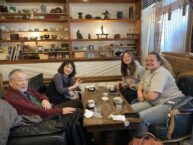My CIP was learning the koto with Iwasaki-sensei. Christine (who was learning the shamisen instead) and I would go to her place every Monday, where we would have about an hour or so of learning our instruments along with the other students. The other students were all older ladies and two gentlemen (one of which was Iwasaki-sensei’s husband), who I feel like would have become like grandmother/father figures for me, if I had had the chance to stay longer. The atmosphere was fun and lively, and the others would often crack jokes and tell funny stories. The actual learning process helped to encourage a rapport between the others, as sensei liked to teach by doing; therefore, my first day in, I had already started to play the opening lines of Sakura. Unfortunately, because the koto is such a large instrument, I could not bring it back home in order to practice, but I think the bonds I formed with the others were more of a priority anyway, and way more worthwhile.
After our lesson, sensei and her husband would treat us all to dinner. I remember feeling very awkward the first night when we went to ChaoChao Gyoza – it had only been my second lesson, so I still didn’t know anyone very well; however, the atmosphere was light, and sensei ordered course after course, and we all shared the various dishes and shared our thoughts on them. This pattern continued for the remaining weeks with Iwasaki sensei. I gradually became a little more outgoing in storytelling, even managing to explain about my long and complicated family ancestry over traditional okonomiyaki. At first, beyond being shy and unconfident in my Japanese, the hardest part about communicating with the group was the fact that understanding the Japanese of older people is a lot more difficult than I thought it would be. I am still not an expert, but you do get better eventually. But through this, I really started to accept that it was okay to make mistakes, and that learning to explain and interpret is just as important as being correct.
What I found helpful was setting a goal for each week in the CIP, not necessarily for the koto, but conversation topics for everyone. One week, my goal was to learn more about what got sensei into learning traditional instruments and her background, and that gradually led to the conversation about my family tree. I would recommend that in any CIP, have a goal for the week if you feel afraid of not having something to speak about. Also, take advantage of spending time with those in the CIP, because those bonds will last a while as well.

Hey Alexis, it looks like you had a really cool and unique CIP experience. I don’t have much experience with traditional Japanese music, but in high school I played in my school’s band. It’s definitely true that you grow bonds with the people you play music with! Is the koto usually played alone, or are there bands that feature the koto among other instruments? If there are bands or koto-playing groups, were you able to play along with some other people who know how to play the koto?
It’s also really cool that you were able to bond with some older community members. I definitely know what you mean when you say understanding the Japanese of older people is more difficult. When I visited my family in Japan over spring break, I had a really tough time understanding the Japanese of my great uncle. I feel like that kind of Japanese is really something you can only experience outside of the classroom!
Thanks for sharing your experience! Whether or not you continue playing the koto, it seems like you definitely got some worthwhile memories out of your CIP!
Yeah it was lots of fun! I definitely would like to pursue learning the koto in the future, by the instruments are definitely pricey and large, and it might be hard to find good teachers, especially at an affordable price. But as for bands, my teacher herself used to perform with her husband who played the shamisen if I remember correctly. There is also a band called ‘Hanafugetsu’ which uses traditional instruments in their songs – the koto and shakuhatchi. As far as I know, I don’t think there is a band consisting entirely of kotos; it’s usually a single instrument accompanied by others. The only time I have seen two kotos was in a performance (I don’t remember what) where there was one player, but she had two different sizes that she played at different points in the song.